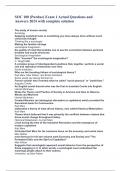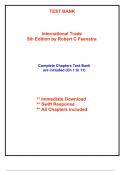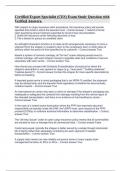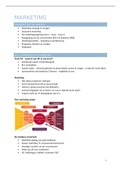MTTC History Practice Exam | Questions And Answers Latest {2024- 2025} A+ Graded |
100% Verified
Where was the first great human civilization located? - The first great human civilization was the
Sumerian civilization which was located in Mesopotamia. Mesopotamia encompasses the area between
the Tigris and Euphrates Rivers in modern-day Iraq and is also referred to as "the Cradle of Civilization,"
and includes part of the Fertile Crescent. The Sumerian civilization is credited with being the first to
practice serious, year round agriculture. There is question over whether Sumeria or Ancient Egypt was
the first to have a written language. Sumeria's writing began hieroglyphically and then developed into a
form of writing known as cuneiform.
Which of the following was not an ancient Egyptian ruler? - Anubis was the Egyptian god of the dead,
typically depicted as being half human and half jackal. Hatshepsut was an Egyptian queen who declared
herself king while acting as regent for her stepson (who was also her son-in-law). She was the fifth
pharaoh of Egypt's 18th dynasty Ramesses (or Ramses) II was the third pharaoh of Egypt's 19th Dynasty,
and Egypt's greatest, most powerful and most celebrated pharaoh. He is also traditionally considered to
be the pharaoh of the Bible's Book of Exodus. His tomb in the Valley of the Kings was discovered in 1881.
Tutankhamen was the boy pharaoh whose tomb was found in 1922, intact and untouched by tomb
raiders, leading to a surge of popular interest in ancient Egypt.
How did the Crusader army that went on the First Crusade differ from the Crusader armies that Pope
Urban II envisioned? - Pope Urban II's plan for an army made up of previously trained military personnel
was thwarted by the popular excitement concerning the First Crusade. This led to the creation of large
armies primarily made up of untrained, unskilled, undisciplined, and ill- or unequipped soldiers, most of
whom were recruited from the poorest levels of society. These armies were the first to set forth on the
Crusade, which became known as the People's Crusade. Even though some of these armies contained
knights, they were ultimately ineffective as fighting forces. These armies were prone to rioting and
raiding surrounding areas for food and supplies and were viewed as a destabilizing influence by local
leaders. They were defeated in battle and many converted to Islam to avoid being killed..
Which western European monastic order developed an early form of banking that helped make
pilgrimages to the Holy Land safer for the pilgrims? - Knights Templar is the name by which the Poor
Fellow-Soldiers of Christ and of the Temple of Solomon is more commonly called. The Knights Templar
began as a small and impoverished order intended to serve as a fighting force in the Holy Land, but soon
grew into a large organization and a favorite charity. As the Templars' resources grew, their operations
did and their activities included the management of an early form of banking that permitted travelers to
carry less money with them, making the travelers a less tempting target for thieves and increasing their
safety.
,Which early feminist work was written by Mary Wollstonecraft? - Mary Wollstonecraft wrote A
Vindication of the Rights of Woman in the late eighteenth century in response to contemporary events
and practices. Wollstonecraft called for equality in education at a time when many people believed that
women only required domestic education that would enable them to run households. The Declaration
of Sentiments was a document addressing the rights of women; it was primarily written by Elizabeth
Cady Stanton and then read to and signed by the delegates to the Seneca Falls Convention. Frankenstein
was written by Mary Wollstonecraft's daughter, Mary Wollstonecraft Shelley. The Awakening was
written by Kate Chopin and published in 1899.
What is the historical significance of the Dome on the Rock's site to Jews? - The Dome of the Rock is the
oldest existing Muslim structure and was built on the traditional site of Mohammed's ascent into heaven
on Temple Mount. Before this, however,the Temple Mount was the site of the Jewish Second Temple
which stood from the 6th Century BC until AD 70 when it was destroyed by Romans in response to a
Jewish uprising in Jerusalem. The Temple Mount is also the traditional site of Solomon's Temple (also
known as the First Temple) and its one remaining wall, known as the Western Wall or the Wailing Wall is
an important Jewish shrine.
How did the Nile shape the Ancient Egyptian Empire? - The Nile River was the lifeblood of the Ancient
Egyptian Empire and is sometimes credited with being the reason this empire was able to become one
of history's most stable societies. Its yearly floods replenished the soil by leaving fertile silt that made
large scale agriculture possible in the land immediately surrounding the river. The agriculture provided
Egypt with goods to trade, further enriching the empire. The Nile was also the center of Egyptian
cultural and spiritual life. The ancient Egyptians believed that the pharaoh was responsible for providing
the yearly floods as part of his role as the divinely appointed ruler.
In which country does a large part of the native, traditionally nomadic people currently live in large tents
known as yurts or gers? - The Mongol people have traditionally been nomads living in large white felt
tents that are commonly known as "yurts" or "gers" and in Mongolia, many of these people still live in
this traditional housing. The term yurt is of Turkish and Russian origins, while ger is the Mongolian term.
The Mongol ger is designed, decorated and positioned based on a strict formula determined by religion,
tradition, and superstition. Today the Mongol people are spread over the Asian steppe region including
Mongolia, and parts of Russia, China Afghanistan and Pakistan.
Which of the following was not a tax levied on the American colonies by the British government in the
1760's and 70's? - The Sugar Act of 1764 raised import duties on goods which were not of British origin,
including sugar, while reducing the import tax on molasses. The Stamp Act of 1765 was a tax of paper
and printed products, intended to help the British government recoup some of the costs of the French
and Indian War. It was extremely unpopular with the colonists and was repealed in 1766. Lead was one
of the goods taxed under the Townshend Acts, enacted in 1767, but it did not receive its own specific
, tax act. The Tea Act of 1773 was another unpopular tax and led to tea boycotts and was the catalyst for
the Boston Tea Party.
To whom was the Declaration of Independence addressed and why? - The Founding Fathers decided
that because the colonies did not have the right to elect representatives to the British Parliament they
could not be justly ruled by Parliament. They envisioned the British Empire's government as being
headed by the King of England, under whom the various local parliaments and legislative bodies served
to enact laws for the peoples whom they represented. By addressing their ills to the king, the Founding
Fathers sought to prevent the appearance that they acknowledged the British Parliament in London as
having any authority over the American colonies.
How did the ruling in Marbury v. Madison alter the Supreme Court's power in the federal government? -
Marbury v. Madison started with the election of Thomas Jefferson as third President of the United
States. The lame-duck Congress responded by issuing a large number of judicial patents, which the
incoming president and Secretary of State refused to deliver to their holders. Marbury, who was to
receive a patent as Justice of the Peace, sued to demand delivery. What makes this case important is the
decision which declared the judiciary's ability to overturn legislation that conflicted with the
Constitution. The case states: "It is emphatically the province and duty of the judicial department to say
what the law is. Those who apply the rule to particular cases must, of necessity, expound and interpret
that rule. If two laws conflict with each other, the courts must decide on the operation of each.\
Which President of the United States changed the date of Thanksgiving from the last Thursday of
November to the fourth Thursday of November? - Abraham Lincoln issued the Thanksgiving
Proclamation on October 3, 1863, in which he specified the last Thursday of November as a day of
thanksgiving. The last Thursday in November was the traditional date for the Thanksgiving holiday for
the next 76 years. In 1939, President Roosevelt tried to change the holiday's date from the last Thursday
in November to the second to last Thursday in November in order to stimulate the economy by creating
a longer Christmas shopping season. This action met with resistance in some parts of the country, and a
compromise was reached in 1941, setting the date of Thanksgiving as the fourth Thursday in November.
Which of the following is an example of historiography? - Historiography can be described as the study
of the study of history. It is a term used to describe the entire body of historical literature, the writing of
history and the critical examination of past historical writings and historical sources. A typical
historiographic essay will be a critical look at the past historical research whether it is a broad look at the
study of history as a whole or of a specific subject that is being analyzed.
Which of the following questions would most likely be asked by a historian concerned with the
philosophy of history? - The philosophy of history is concerned with the ultimate significance of history
as a field of study and asks questions concerning how history should be studied, including what social






